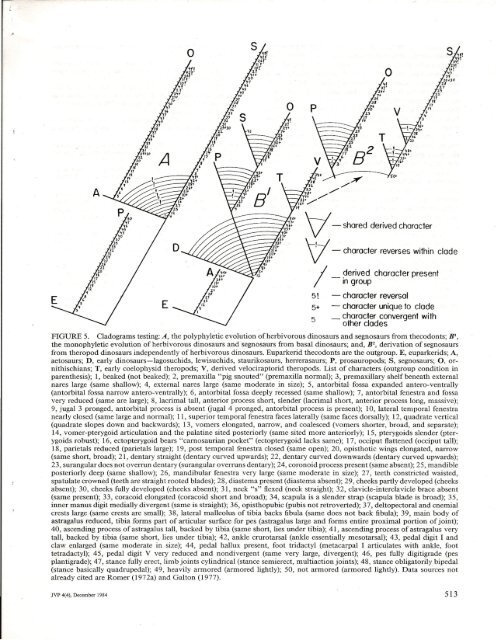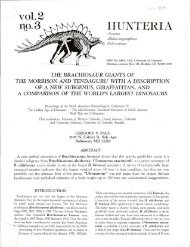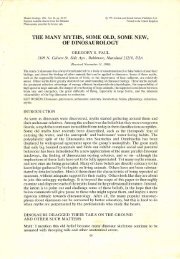THE SEGNOSAURIAN DINOSAURS: RELICS OF ... - Gregory S. Paul
THE SEGNOSAURIAN DINOSAURS: RELICS OF ... - Gregory S. Paul
THE SEGNOSAURIAN DINOSAURS: RELICS OF ... - Gregory S. Paul
You also want an ePaper? Increase the reach of your titles
YUMPU automatically turns print PDFs into web optimized ePapers that Google loves.
SOt<br />
~----.Jv1l·<br />
_ ::::::==:;t;,~t<br />
}7'<br />
~--"'J5'<br />
l3'<br />
11'<br />
ll.<br />
20t<br />
,t<br />
i'<br />
s-<br />
I~<br />
I)' ".<br />
o<br />
v-shared derived character<br />
V-character reverses within clade<br />
/: derived character present<br />
In group<br />
5!<br />
5+<br />
5<br />
- character reversal<br />
- character unique to clade<br />
_ character convergent with<br />
other clades<br />
FIGURE 5. Cladograms testing: A, the polyphyletic evolution of herbivorous dinosaurs and segnosaurs from thecodonts; B',<br />
the monophyletic evolution of herbivorous dinosaurs and segnosaurs from basal dinosaurs; and, B', derivation ofsegnosaurs<br />
from theropod dinosaurs independently of herbivorous dinosaurs. Euparkerid thecodonts are the outgroup. E, euparkerids; A,<br />
aetosaurs; D, early dinosaurs-lagosuchids, lewisuchids, staurikosaurs, herrerasaurs; .P, prosauropods; S, segnosaurs; 0, ornithischians;<br />
T, early coelophysid theropods; V, derived velociraptorid theropods. List of characters (outgroup condition in<br />
parenthesis); 1, beaked (not beaked); 2, premaxilla "pig snouted" (premaxilla normal); J, premaxillary shelf beneath external<br />
nares large (same shallow); 4, external nares large (same moderate in size); 5, antorbital fossa expanded antero-ventrally<br />
(antorbital fossa narrow antero-ventrally); 6, antorbital fossa deeply recessed (same shallow); 7, antorbital fenestra and fossa<br />
very reduced (same are large); 8, lacrimal tall, anterior process short, slender (lacrimal short, anterior process long, massive);<br />
9, jugal 3 pronged, antorbital process is absent (jugal 4 pronged, antorbital process is present); 10, lateral temporal fenestra<br />
nearly closed (same large and normal); 11, superior temporal fenestra faces laterally (same faces dorsally); 12, quadrate vertical<br />
(quadrate slopes down and backwards); 13, vomers elongated, narrow, and coalesced (vomers shorter, 'broad, and separate);<br />
14, vomer-pterygoid articulation am! the palatine sited posteriorly (same sited more anteriorly); 15, pterygoids slender (pterygoids<br />
robust); 16, ectopterygoid bears "carnosaurian pocket" (ectopterygoid lacks same); 17, occiput flattened (occiput tall);<br />
18, parietals reduced (parietals large); 19, post temporal fenestra closed (same open); 20, opisthotic wings elongated, narrow<br />
(same short, broad); 21, dentary straight (dentary curved upwards); 22, dentary curved downwards (dentary curved upwards);<br />
23, surangular does not overrun dentary (surangular overruns dentary); 24, coronoid process present (same absent); 25, mandible<br />
posteriorly deep (same shallow); 26, mandibular fenestra very large (same moderate in size); 27, teeth constricted waisted,<br />
spatulate crowned (teeth are straight rooted blades); 28, diastema present (diastema absent); 29, cheeks partly developed (cheeks<br />
absent); 30, cheeks fully developed (cheeks absent); 31, neck "s" flexed (neck straight); 32, clavicle-interclavicle brace absent<br />
(same present); 33, coracoid elongated (coracoid short and broad); 34, scapula is a slender strap (scapula blade is broad); 35,<br />
inner manus digit medially divergent (same is straight); 36, opisthopubic (pubis not retroverted); 37, deltopectoral and cnemial<br />
crests large (same crests are small); 38, lateral malleolus of tibia backs fibula (same does not back fibula); 39, main body of<br />
astragalus reduced, tibia forms part of articular surface for pes (astragalus large and forms entire proximal portion of joint);<br />
40, ascending process of astragalus tall, backed by tibia (same short, lies under tibia); 41, ascending process of astragalus very<br />
tall, backed by tibia (same short, lies under tibia); 42, ankle crurotarsal (ankle essentially mesotarsal); 43, pedal digit I and<br />
claw enlarged (same moderate in size); 44, pedal hallux present, foot tridactyl (metacarpal I articulates with ankle, foot<br />
tetradactyl); 45, pedal digit V very reduced and nondivergent (same very large, divergent); 46, pes fully digitigrade (pes<br />
plantigrade); 47, stance fully erect, limb joints cylindrical (stance semierect, multiaction joints); 48, stance obligatorily bipedal<br />
(stance basically quadrupedal); 49, heavily armored (armored lightly); 50, not armored (armored lightly). Data sources not<br />
already cited are Romer (1972a) and Galton (1977).<br />
JVP 4(4), December 1984 513









